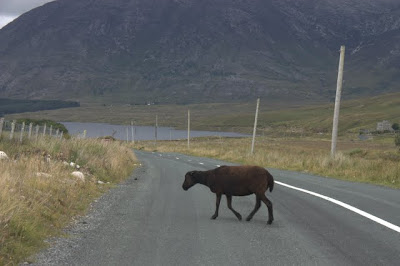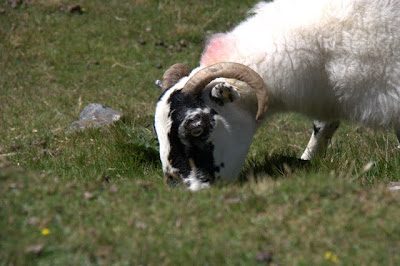The Sheep Rules
After being surrounded by the wooly critters at Mont St. Michel, I developed a certain affinity towards sheep. Driving around the Ireland countryside turned my affinity into a full-blown obsession.
You can’t avoid the sheep in Ireland. They are EVERYWHERE. Real ones, wandering around the green grasses. By the sea. Inland. Up the hills, out on cliffs, on flat land. Ambling across the road. Even black ones. Fake ones, in every Irish gift shop. On t-shirts. As stuffed animals.
The sheep are really what make the Irish countryside, in my opinion. Their shaggy off-white coats provide the perfect contrast to the vibrant green grasses. On the rare sunny day, the sheep mirror the fluffy white clouds in the sky. Sometimes, all you can see for miles is shades of blue in the ocean and sky, shades of green grasses, and shades of white in the clouds and sheep. Other times, the gray takes predominance over every other color. Even then, the wooly white still dots the landscape.
More often than not, the sheep add even more colors to the mix. The vast majority of the sheep are painted with some sort of bright color. I assumed the paint was some sort of marking system for the farmers, but I didn’t understand why some of the markings were so extensive. I later learned that the paint is washable and not permanent, and subsequently saw the proof in the window of a vet clinic:
I am sure that the branding spray is a practical solution to wandering sheep, but it interfered with my quest for a photo of the quintessential Irish landscape.
You would think by looking at my sheep photos that the sheep do something else besides eat. That would be a lie. Sheep are really just wooly, fuzzy pigs in disguise. They eat, constantly. It took hundreds of pictures of sheep to come up with ones where you could actually see anything other than there wooly butts. Their heads are always downward. They are worse than ostriches.
In order to maximize the opportunities for the best sheep photos, we had to develop the sheep rules. We were travelling in a two-car caravan without cell phones. As we learned the hard way, it is impossible for the second car to stop on its own accord. Thus, the sheep rules were born:
- We should stop for sheep that are wooly and fuzzy and unshaven.
- We should stop for sheep that are not branded with spray.
- We should stop for sheep that are by the sea.
- We must stop for any combination of the above.
Somehow, although there was much talk of the sheep rules, no one ever really enforced the failure to follow the rules. Besides, no matter where and when we stopped, there were some kind of sheep to be found.
Initially, we mistook certain sheep as goats. We thought horns were an indentifying feature of a goat, but it turns out that it is the tail. Sheep have tails that stand straight up, and goats have tails that point downward. Or maybe it was the other way around. Who knew? We didn’t. Standing on the side of the road on Conor’s Pass, a one six-foot lane pass through a mountain covered in sheep and fog, the six of us tried to remember our farm animals. I actually think they are goats, not sheep. No, they’re sheep! Wait, are sheep and goats the same animal? Not sure, but what’s a lamb? Baby sheep, right? Hmm, what’s an alpaca? I should be an alpaca farmer. Being the city folk that we are, we had to turn to The Google for answers.
One thing we didn’t ask The Google was why the sheep were being raised. Naively, we all assumed the sheep were there to shaved and shorn and later worn as one of the million wool sweaters sold all over Ireland. Then they would go on living their happy little sheep lives grazing by the sea while the owner of the sweater was nice and toasty warm. It was a sad day when we learned that may not be the case. As our last stop on the island of Ireland, we stayed at a beef and sheep farm to get up close and personal with the sheep. There, the farmer told us that he only gets 1.00 for the wool, but it costs him 1.50 to have the sheep shaved. So, what do you raise the sheep for? I asked, not wanting to hear the answer. Meat, he answered, simply. I paused before I asked the next question. You said you mostly have lambs. Do you raise them for meat, too? Yep, he said, cheerily. We kill everything!













